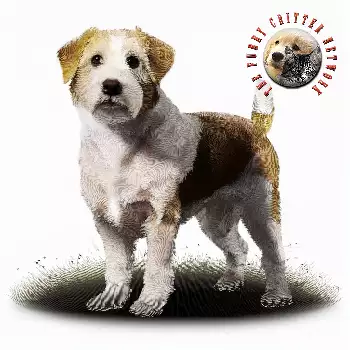The remarkable history of the Kromi begins in the aftermath of World War II, making it one of the youngest recognized dog breeds with a truly unique origin story. Unlike breeds that evolved over centuries through gradual development, the Kromi's creation can be traced to a specific time, place, and even individual dogs, representing a fascinating example of deliberate breed creation in the modern era.
The foundation of the breed centers around a scruffy, charismatic dog named "Original Peter," who became an unlikely mascot for American troops during World War II. Historical accounts vary slightly in detail, but the core story remains consistent: Peter was discovered by American soldiers in northern France, likely a mixed-breed dog whose ancestry included terrier and possibly Grand Basset Griffon Vendéen bloodlines. His engaging personality and loyalty quickly endeared him to the troops, who adopted him as their unit mascot.
As the war concluded and military units were reorganized, Peter found himself separated from his American companions. In a stroke of fortune that would prove pivotal to dog breed history, Peter was discovered and rescued by Ilse Schleifenbaum, a German woman living in the Siegen area of North Rhine-Westphalia. Recognizing Peter's exceptional temperament and distinctive appearance, Schleifenbaum decided to keep him as a companion.
The next chapter in the breed's development occurred when Peter met Fifi, a black-and-white Wire Fox Terrier belonging to Schleifenbaum. Their union produced puppies who displayed remarkable consistency in both temperament and appearance, inheriting Peter's unique charm and distinctive coat patterns. Two puppies from this litter, Shaggy and Witch, particularly captured Schleifenbaum's attention with their exceptional qualities and strong resemblance to their father.
Inspired by the remarkable qualities she observed in these dogs, Schleifenbaum embarked on an ambitious project to develop an entirely new breed focused solely on companionship. This represented a revolutionary concept in dog breeding at the time, as most breeds were developed for specific working purposes such as hunting, herding, or guarding. Schleifenbaum's vision was to create a dog whose primary function would be to provide loyal, loving companionship to families.
The breed's name "Kromfohrländer" emerged from the local landscape where development took place. "Krom fohr" translates to "crooked furrow" in the local dialect, referring to the rolling agricultural terrain of the Siegen region. This poetic name perfectly captured both the geographic origins of the breed and its connection to the German countryside where Schleifenbaum conducted her breeding program.
Working alongside Otto Borner, who later played a crucial role in restructuring the German Kennel Club (VDH), Schleifenbaum spent over a decade carefully developing and refining the breed. Their systematic approach focused on establishing consistent type, sound temperament, and robust health while maintaining the unique characteristics that made these dogs special. This methodical breeding program represented cutting-edge practices for companion animal development in the 1940s and 1950s.
The dedication and careful work of Schleifenbaum and Borner achieved official recognition when the Fédération Cynologique Internationale granted full breed status to the Kromfohrländer in August 1955. This recognition represented a significant milestone, establishing the Kromi as Germany's first post-war breed and one of the few breeds developed exclusively for companionship rather than working function.
International expansion of the breed began in the late 1960s when breeding programs were established in Finland, followed by development in Austria, Sweden, Denmark, and Norway throughout the following decades. Each country's breeding program worked to maintain the breed's distinctive characteristics while adapting to local conditions and preferences.
The breed's introduction to North America occurred much later, with the first Kromis arriving in the United States in the early 2000s. American breed enthusiasts worked diligently to establish breeding programs and promote awareness of this unique German breed. Their efforts culminated in American Kennel Club recognition in 2017, when the Kromi was admitted to the Non-Sporting Group, marking a significant achievement for this relatively rare breed.
Today, the Kromi continues to embody Ilse Schleifenbaum's original vision of the perfect family companion. Modern breeding programs worldwide focus on maintaining the breed's exceptional temperament, distinctive appearance, and robust health while ensuring genetic diversity for long-term sustainability. The breed serves as a testament to thoughtful, purpose-driven breeding practices and the enduring appeal of a dog created specifically to share human companionship.

